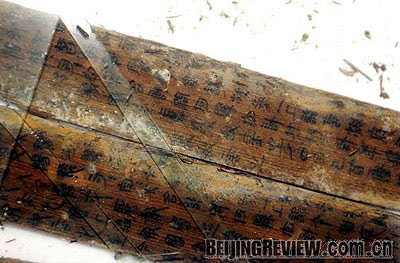
Archaeologists in China have discovered a trove of rare bamboo-strip books uncovered within an excavated tomb in Yancang, a village near Jingmen in Hubei province.
Experts believe the site dates back to the Warring States Period (475 BC to 221 BC) and hope that the books will reveal the name of the entombed owner; it is possible that the strips contain a written introduction by the owner of the tomb, “like a letter of recommendation the deceased would carry with them to the underworld to give Yanluo, the god of death,” Shen Haining, director of the provincial cultural heritage bureau, told China Daily.
“We cannot tell how many we’ve got and we have no idea what’s written on them, but the discovery of bamboo strips itself is exciting,” he continued.
Excavation of the tomb will be completed next week before any attempt is made to read the bamboo strips. “Sorting out those bamboo strips is like sorting out well-cooked noodles, you have to be really careful so as not to damage them.”
The ancient Chinese believed Yanluo was not only the ruler but also the judge of the underworld; the deceased would bury with them an introduction letter detailing their good deeds and achievements during their life to guarantee a better afterlife.
Bamboo-strip books are the best materials to study the earliest Chinese manuscripts because the emperor, Qin Shihuang, ordered most documents to be destroyed after he united China in 221 BC.
The emperor ordered all books except those about the Qin dynasty’s history and culture, divination and medicines to be burned.
“As the historical documents about the early part of China’s history that have been passed down are very rare, bamboo strips today are very valuable,” Shen said.
The discovery in 1993 of almost 800 bamboo strips dating back to the Warring States Period in a tomb in Hubei was a major find and international sensation: They contained the complete pre-Qin transcription of Tao Te Ching by Lao Tzu, founder of the Taoist school of thought.
_________
Full story at China Daily.
Bamboo-strip book images courtesy of Beijing Review.


